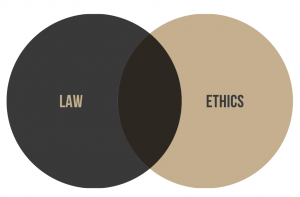Part 1: The Relationship of Legal and Ethical Duties
4 What are examples of when legal and ethical duties diverge?
What may be ethically required and legally permissible or required may also diverge. Often the easiest examples stem from situations with emergency or necessity, or from historical practices which violate modern senses of ethics.
For instance, while a posted speed limit may state the maximum legal speed, efforts to drive to a hospital to save a life may create an ethical duty to exceed that speed. Of course, if one exceeds the posted speed limit they may put others in danger, and any ethical consideration would need to take that into account. Or, trespassing on another’s property to save someone from injury or death may not just be ethically permissible, but ethically required by the moral code of many individuals.

History also provides many examples, from the protection of slavery for much of United States history, to legal protections for child labor that existed up until the twentieth century, and so on. Over time, legal protections and society’s sense of ethics in these situations changed dramatically.

Exercises
- For the company in Question 1, discuss briefly how the legal and ethical duties faced by the company diverge, if at all.

